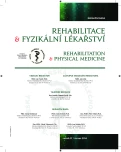Social Rehabilitation – Specific Aspects in Integration of Persons with Visual Disability
Authors:
J. Bienertová
Authors‘ workplace:
Zdravotně sociální fakulta, Jihočeská univerzita v Českých Budějovicích
Published in:
Rehabil. fyz. Lék., 21, 2014, No. 2, pp. 80-85.
Category:
Case Report
Overview
People with visual disabilities are a diverse group of people with reduced or absent function of vision. The quality of visual perception is determined by measuring visual acuity and visual field. Provide some compensation here especially the remaining senses - touch, hearing, smell, taste, mental activity - thinking, memory, imagination, creativity and mobility aids - for self-care, spatial orientation and independent movement, working with text and graphic information, etc. To increase quality of life of these people are implemented certain system solutions (in health, education and learning, social security, employment, accessibility to the physical environment, access to information and cultural heritage, etc.). Types of interventions and support services (for equalization of opportunities of persons with visual disabilities) varies depending on the age (early intervention , integrated education and training in schools for pupils with visual impairment, guide and reader services, facilities for the provision of social rehabilitation, etc.) the persons with visual disabilities.
The present case report outlines the problems of coping with sudden visual impairment and experiments/ approaches the subsequent integration.
Keywords:
disability, integration, intervention, communication, visual impairment
Sources
1. BIENERTOVÁ, J.: Rehabilitace – psychosociální aspekty ovlivňující integraci osob s disabilitou mezi ekonomicky aktivní. Rehabilitácia, roč. 49, 2012, č. 4, s. 232-237, ISSN 0375-0922.
2. CERHA, J.: Desatero při kontaktu se slabozrakým člověkem. [online] Tyfloservis, 2007. Dostupné na: http://www.fyfloservis.cz/doc./kontakt-se-slabozrakym-ts-2007.pdf [cit. 15. 03. 2010].
3. GRICE, H. P.: Studies in the way of words. Cambridge: Harvard University Press, 1991, s. 269-286.
4. HRNČÍŘ, E.: Motivace - významný faktor pro zařazování osob s profesionálním postižením zdraví do práce. Pracovní lékařství, roč. 55, 2003, č. 1, s. 34-37.
5. IVANOVOVÁ, S.: Integrace zdravotně postižených osob do společnosti. [online] Studijně rozborová zpráva vznikla v rámci studia na Ústavu informačních studií a knihovnictví v roce 2001. Vědecká knihovna Olomouci, 2001, Dostupné na: http://www.vkol.cz/cs/dokumenty/referaty-a-soupisy--nejen--pracovniku-vkol/prehled-referatu/clanek/integrace-zdravotne-postizenych-osob-do-spolecnosti/ [cit. 3. 7. 2013].
6. JESENSKÝ, J. a kol.: Prolegomena systému tyflorehabilitace a metodiky tyflorehabilitačních výcviků a přípravy rehabilitačně-edukačních pracovníků tyflopedického spektra. 1. vyd. Praha, Univerzita Jana Amose Komenského, 2007, 660 s.
7. KAVALÍROVÁ, K.: Nevidomý ve vaší firmě. 1. vyd., Praha, Okamžik, 2012, 52 s.
8. KEYES, C. L. M., HAIDT, J. Flourishing: positive psychology and the life well-lived. American Psychological Association (APA), 2002, 335 s.
9. MICHALÍK, J. a kol.: Zdravotní postižení a pomáhající profese. 1. vyd., Praha, Portál, 2011, 512 s.
10. PLUHAŘOVÁ, D.: Komunikační principy v procesu integrace těžce zrakově postižených. [online] Tyflologicié listy, 1999, 1-2. Dostupné na: http://www.braillnet.cz/sons/docs/tl99/08.html [cit. 19. 8. 2009].
11. RENOTIÉROVÁ, M., LUDÍKOVÁ, L.: Speciální pedagogika. 4. vyd., Olomouc, Univerzita Palackého, 2006, 313 s.
12. SLOWÍK, J.: Komunikace s lidmi s postižením. 1. vyd., Praha, Portál, 2010, 160 s.
13. VÁGNEROVÁ, M.: Psychopatologie pro pomáhající profese. 3. vyd., Praha, Portál, 2002, 444 s.
14. VÁGNEROVÁ, M.: Psychopatologie pro pomáhající profese. 4. vyd. Praha, Portál, 2008, 872 s.
Labels
Physiotherapist, university degree Rehabilitation Sports medicineArticle was published in
Rehabilitation & Physical Medicine

2014 Issue 2
Most read in this issue
- Differential Diagnostics of „Scapula Alata”
- Evaluation of Postural Stability Using Functional Tests in a Group of Subjects with Transtibial Amputation (A Pilot Study)
- Electroencephalographic Correlates of Performance Motivation and Fatigue
- Rehabilitation Method KLIM-THERAPY – Reflections on the Mechanisms of Clinical Effect
